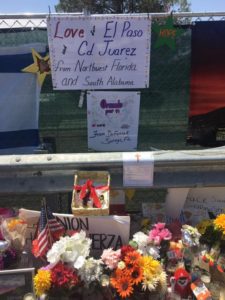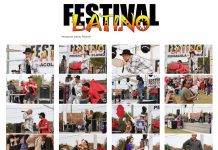El duelo de una ciudad
Ha pasado un mes desde el tiroteo en El Paso, Texas. Los titulares de las noticias han pasado de la terrible experiencia a reacciones políticas e incluso otros tiroteos que han ocurrido en otras partes del país.
Pero en El Paso, un flujo constante de visitantes continúa fluyendo hacia un monumento improvisado fuera de Walmart donde ocurrió el tiroteo.
Una colección masiva de flores, velas y mensajes de simpatía y aliento han bordeado una calle al lado de la tienda. Personas de diferentes ámbitos de la vida y partes del país han viajado al monumento para presentar sus respetos y algunos intentan encontrar el cierre de la increíble pesadilla que ocurrió el 3 de agosto de 2019.
April Carrizal Avitia, vivía al otro lado de la autopista (Interestatal 10) de la tienda, pero se mudó a San Antonio solo una semana antes del tiroteo. Regresó a El Paso y visitó el monumento el 2 de septiembre.
“Al comprar en la misma tienda, comienzas a conocer a las personas que trabajan allí. Se vuelven como una familia,” dijo Avitia. “Tenía muchas preguntas y sentía ira.”
Avitia dijo que fue al monumento con la esperanza de encontrar una carta de los padres de los tiradores, algún tipo de disculpa o explicación de lo que su hijo había hecho.
Algunos habitantes de El Paso no pueden encontrar la fuerza para visitar el monumento. Ya sea por temor a saber que alguien condujo diez horas a El Paso para “matar a tantos mexicanos como pudo,” como dijo el tirador según los informes, o la inmensa tristeza de saber que 22 personas fueron asesinadas en un lugar tan casualmente frecuentado, Algunas personas simplemente no quieren visitar el monumento o incluso hablar sobre lo que sucedió ahí.
La costa del Golfo es el hogar de varias personas que crecieron en el área de El Paso – Cd Juárez. Algunos participaron en una manifestación contra la violencia armada en Pensacola para expresar su apoyo a sus familiares y amigos en su ciudad natal.
Grace Resendez McCaffery, propietaria y editora del periódico La Costa Latina, habló en el mitin.
“Me voy a casa a El Paso para abrazar a mis padres y amigos que tuvieron la suerte de no estar donde esta atroz muestra de odio ocurrió en el momento en que tantas personas inocentes fueron asesinadas. Vamos a disfrutar el tiempo que tenemos juntos sabiendo cuán cerca estuvimos de perder esta oportunidad porque, como he escuchado a tanta gente en casa decir, podría haber sido cualquiera de nosotros,” dijo McCaffery en un discurso.
Uno de los asistentes a la manifestación le dio a McCaffery un regalo para darle a un familiar de una de las víctimas. Era una colorida manta hecha a mano inspirada en el arte de Freida Khalo. McCaffery se lo dio a un amigo de la infancia que es primo de Arturo Benavides, una de las víctimas del tiroteo. La manta fue entregada a la viuda de Benavides.
El proceso de curación continúa a medida que aumenta la cantidad de dolientes después de cada tiroteo que parece estar ocurriendo con mayor frecuencia, y ciudades como El Paso aprenden a recoger las piezas y continuar.
A city’s mourning
 A month has passed since the shooting in El Paso, Tex. News headlines have shifted from the horrific ordeal to political reactions and even other shootings that have occurred in other parts of the country.
A month has passed since the shooting in El Paso, Tex. News headlines have shifted from the horrific ordeal to political reactions and even other shootings that have occurred in other parts of the country.
But in El Paso, a steady stream of visitors continues to flow to a makeshift memorial outside the Walmart where the shooting occurred.
A massive collection of flowers, candles and messages of sympathy and encouragement have lined a street at the side of the store. People from different walks of life and parts of the country have travelled to the memorial to pay their respects and some try to find closure to un unbelieveable nightmare that occurred on August 3, 2019.
April Carrizal Avitia, lived across the freeway (Interstate 10) from the store, but moved to San Antonio just a week before the shooting. She drove back to El Paso and visited the memorial on September 2.
“Shopping at the same store, you begin to know the people who work there. They become like family,” Avitia said. “I had a lot of quesitons and felt anger.”
Avitia said she went to the memorial hoping to find a letter from the shooters parents, some kind of apology or explanation for what their son had done.
Some El Pasoans cannot find the strength to visit the memorial. Whether out of fear of knowing that someone drove ten hours to El Paso to “kill as many mexicans as he could” as the shooter said according to reports, or the emense sadness of knowing that 22 people were murdered in a place so casually frequented, some people simply do not want to visit the memorial or even talk about what happened there.
The Gulf Coast is home to several people who grew up in the El Paso – Cd Juarez area. Some participated an anti-gun violence rally in Pensacola to express their support for their family and friends in their hometown.
Grace Resendez McCaffery, owner and editor of La Costa Latina Newspaper spoke at the rally.
“I am going home to El Paso to hug my parents and friends who were fortunate enough to not be where this atrocious display of hatred occurred at the moment when so many innocent people were killed. We are going enjoy the time we have together knowing how close we came to losing this opportunity because as I have heard so many people back home say, it could have been any one of us,” McCaffery said in a speech.
One attendee of the rally gave McCaffery a gift to give to a family member of one of the victims. It was a colorful handmade blanket inspired by the art of Freida Khalo. McCaffery gave it to a childhood friend who is the cousin of Arturo Benavides, one of the victims in the shooting. The blanket was given to his Benavides’ widow.
The healing process continues as the amount of mourners increases after each shooting that appear to be happening more frequently, and cities like El Paso learn to pick up the pieces and carry on.












